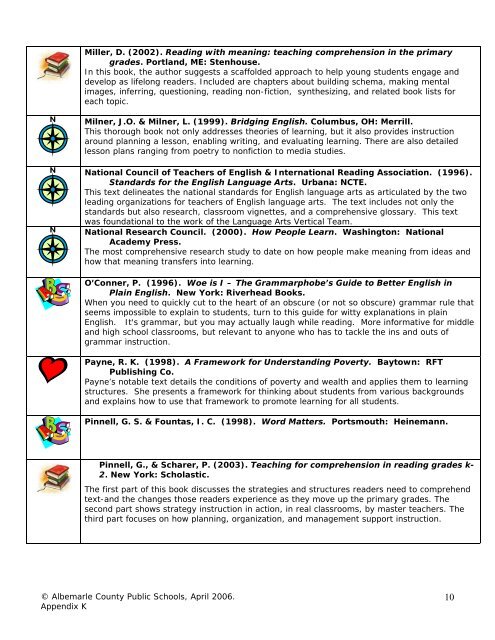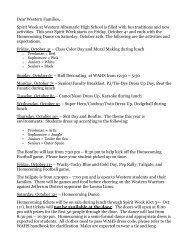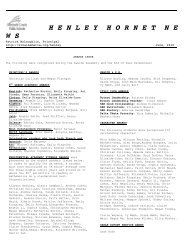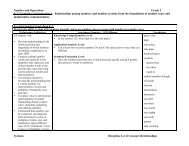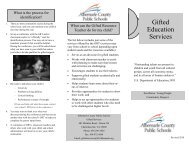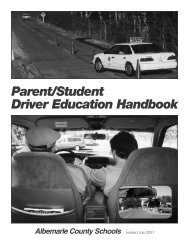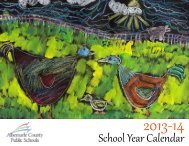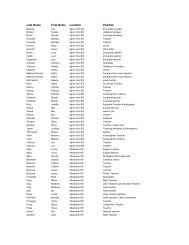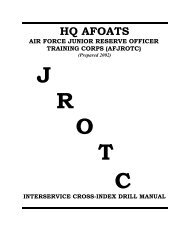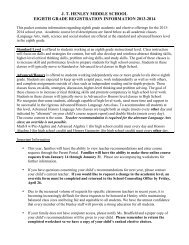Language Arts/English Curriculum Frameworks - Albemarle County ...
Language Arts/English Curriculum Frameworks - Albemarle County ...
Language Arts/English Curriculum Frameworks - Albemarle County ...
Create successful ePaper yourself
Turn your PDF publications into a flip-book with our unique Google optimized e-Paper software.
Miller, D. (2002). Reading with meaning: teaching comprehension in the primary<br />
grades. Portland, ME: Stenhouse.<br />
In this book, the author suggests a scaffolded approach to help young students engage and<br />
develop as lifelong readers. Included are chapters about building schema, making mental<br />
images, inferring, questioning, reading non-fiction, synthesizing, and related book lists for<br />
each topic.<br />
Milner, J.O. & Milner, L. (1999). Bridging <strong>English</strong>. Columbus, OH: Merrill.<br />
This thorough book not only addresses theories of learning, but it also provides instruction<br />
around planning a lesson, enabling writing, and evaluating learning. There are also detailed<br />
lesson plans ranging from poetry to nonfiction to media studies.<br />
National Council of Teachers of <strong>English</strong> & International Reading Association. (1996).<br />
Standards for the <strong>English</strong> <strong>Language</strong> <strong>Arts</strong>. Urbana: NCTE.<br />
This text delineates the national standards for <strong>English</strong> language arts as articulated by the two<br />
leading organizations for teachers of <strong>English</strong> language arts. The text includes not only the<br />
standards but also research, classroom vignettes, and a comprehensive glossary. This text<br />
was foundational to the work of the <strong>Language</strong> <strong>Arts</strong> Vertical Team.<br />
National Research Council. (2000). How People Learn. Washington: National<br />
Academy Press.<br />
The most comprehensive research study to date on how people make meaning from ideas and<br />
how that meaning transfers into learning.<br />
O’Conner, P. (1996). Woe is I – The Grammarphobe’s Guide to Better <strong>English</strong> in<br />
Plain <strong>English</strong>. New York: Riverhead Books.<br />
When you need to quickly cut to the heart of an obscure (or not so obscure) grammar rule that<br />
seems impossible to explain to students, turn to this guide for witty explanations in plain<br />
<strong>English</strong>. It's grammar, but you may actually laugh while reading. More informative for middle<br />
and high school classrooms, but relevant to anyone who has to tackle the ins and outs of<br />
grammar instruction.<br />
Payne, R. K. (1998). A Framework for Understanding Poverty. Baytown: RFT<br />
Publishing Co.<br />
Payne’s notable text details the conditions of poverty and wealth and applies them to learning<br />
structures. She presents a framework for thinking about students from various backgrounds<br />
and explains how to use that framework to promote learning for all students.<br />
Pinnell, G. S. & Fountas, I. C. (1998). Word Matters. Portsmouth: Heinemann.<br />
Pinnell, G., & Scharer, P. (2003). Teaching for comprehension in reading grades k-<br />
2. New York: Scholastic.<br />
The first part of this book discusses the strategies and structures readers need to comprehend<br />
text-and the changes those readers experience as they move up the primary grades. The<br />
second part shows strategy instruction in action, in real classrooms, by master teachers. The<br />
third part focuses on how planning, organization, and management support instruction.<br />
© <strong>Albemarle</strong> <strong>County</strong> Public Schools, April 2006.<br />
Appendix K<br />
10


